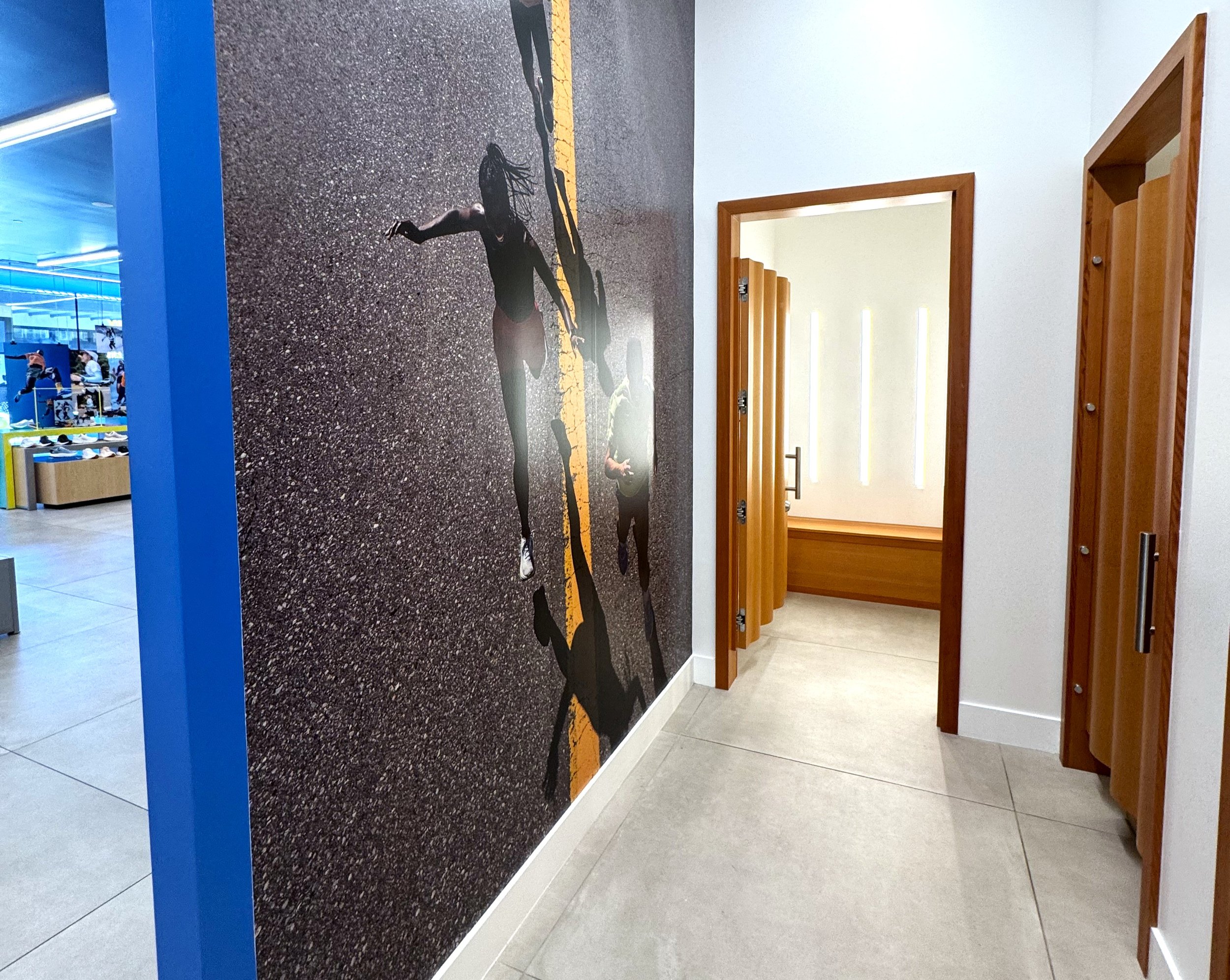How Innovative Fitting Rooms Enhance the Shopping Experience
In the world of retail, every square foot of space plays a role in creating a memorable shopping experience. Yet, fitting rooms are often overlooked and added as an afterthought. A well-designed fitting room, however, is the cherry on top of a thoughtfully crafted retail environment. It’s where final decisions are made, confidence is built, and customer loyalty is won. When designed with intention, fitting rooms elevate the entire shopping experience.
In this article, we’ll explore the key elements of exceptionally designed fitting rooms and why investing in these spaces can pay off in big ways for your business.
HOKA Sportsmen’s Lodge (December, 2024) fitting rooms.
Why Fitting Rooms Matter?
Fitting rooms are more than just spaces to try on clothes—they’re the ultimate decision-making zone. This is where customers go from “Maybe?” to “Yes!” or “No.” making them a crucial area in any retail store. A well-designed fitting room creates a private, comfortable environment where shoppers can see themselves in products, boosting their confidence and increasing the likelihood of a purchase. Neglecting this space risks leaving customers frustrated or dissatisfied, which can turn a potential sale into a lost opportunity or a high return rate. When done right, fitting rooms enhance customer satisfaction, improve sales conversions, and leave a lasting impression of your brand.
Designing The Customer’s Journey to the Fitting Rooms
The fitting room experience starts as soon as a user decides to try on a product, even if the customer is still browsing for more items. From space planning to storytelling elements, retailers need to consider their customer’s journey. Below are ways retailers can intentionally enhance their customer’s experience.
Create Clear Wayfinding
Nothing is more frustrating than a space that is difficult to navigate. Clear wayfinding is essential to help shoppers easily locate fitting rooms. When customers can easily find fitting rooms, they’re more likely to try on items and ultimately make a purchase.
Adidas Abbot Kinney (December, 2024) uses text and graphics on the ground to help customers easily find their way.
Atelier The Americana at Brand (December, 2024) uses neon signage for fitting room wayfinding.
Consider the Entry Foyer
Don’t underestimate the entry foyer leading into the fitting rooms. This area is an excellent opportunity to reinforce your brand identity through thoughtful design, messaging, and graphics. A welcoming, on-brand entry sets the tone for what shoppers will experience inside, creating a seamless and memorable journey from the sales floor to the fitting rooms.
Add Nearby Seating
Seating near the fitting rooms is a simple yet impactful design feature that serves multiple purposes. For customers waiting to try on during busy times, it provides a comfortable place to pause instead of standing in line. It’s also a thoughtful addition for companions who are there to support the shopper. Lastly, seating in proximity to fitting rooms enhances the overall flow of the space and creates a more relaxed and inviting atmosphere. This small touch can significantly elevate the customer experience, making your store feel both functional and welcoming.
Rhone Fashion Island (December, 2024) adds seating in fitting room foyer.
Evereve (December, 2024) creates an inviting foyer for fitting rooms.
Designing the Inside of the Fitting Rooms
Once inside a fitting room, it’s time for the products to shine! The following are how retailers can create an exceptional shopping experience for their customers.
Connect Through Educational Moments
Fitting rooms are one of the few places in a retail store where you have the customer’s undivided attention—often for several minutes—right when they’re making crucial buying decisions. This makes it an ideal space for sharing valuable, educational content. Consider using signage to provide tips on finding the right fit, what makes your product unique, or styling options. This assists the customer in their decision-making process and enhances their overall experience, leaving them feeling more confident and connected to your brand.
Brixton Fashion Island (December, 2024) includes a hat fit graphic inside their fitting rooms.
Rapha Seattle Clubhouse (April, 2024) adds a build your outfit graphic in each fitting room.
Create Delight
While many retailers opt for plain and unremarkable fitting rooms, these spaces hold immense potential for creativity. Vibrant colors and eye-catching patterns turn ordinary fitting rooms into an unexpected delight. Bold and playful spaces are perfect for encouraging selfies, creating “Instagrammable” moments that customers will want to share. Thus, making the fitting room a memorable part of the shopping experience.
Choose the Right Lighting Solution
Lighting can make or break the fitting room experience. Good lighting should come from multiple sources to eliminate shadows and ensure the customer sees themselves—and your products—in the best possible light. Combine overhead and side lighting to create an even, flattering glow that highlights textures, colors, and fits accurately.
Snowpeak Portland (April, 2024) uses lighting and materials that create delight for their customers and align with their brand.
Elevate the Functional Details
Functional details such as a seating bench, hooks, and mirror(s) are the backbone of any fitting room, but they don’t have to be purely functional. Opt for materials and finishes that align with your store’s overall aesthetic. Elevating the details to create a cohesive and memorable experience that feels intentional and on-brand.
Designing Fitting Rooms for Smaller Spaces
Just because your space doesn’t have an obvious area for fitting rooms, doesn’t mean you should ditch them altogether. Pop-ups and temporary spaces commonly have smaller footprints, but can still accommodate a fitting room with a clever design solution. The bottom line is if you carry apparel in your store you need a space for your customers to try on products.
Left on Friday Abbot Kinney (December, 2024) uses retractable curtains and mirrors to include fitting rooms in their small space.
Pleasing Abbot Kinney (December, 2024) creates a showcase space to make their fitting rooms usable.
Design for Privacy First
When designing in a small space, the number one consideration is the privacy for the user. The space should be large enough for someone to comfortably change without worrying about any body parts or belongings sticking out as well as being completely blocked from the view of anyone outside the space.
Pair with a Showcase Space
A showcase area provides the perfect counterpart as the retractable curtain model can’t fit all the necessary design elements. This space can accommodate the user’s guests, have a beautiful lighting solution, and include storytelling elements. This area can also be used for customers who want a look at items that don’t require a fitting room such as headwear or accessories to free up fitting rooms for your customers who need them.
Ready to Open Your Next Unforgettable Location?
Now that you understand why fitting rooms are an important part of any retail space and how to design them to enhance your customers’ experience, it’s time to create your next unforgettable location. With over 15 years of architecture, in-house brand, and design agency experience for influential brands including HOKA, Arc’teryx, Nike, Adidas, and Garmin, Feels on Brand is the go-to retail experience design studio for creating unforgettable retail spaces. Together, we'll help navigate designing and implementing your next retail brand experience. Download our Investment Guide to learn how to get started.











